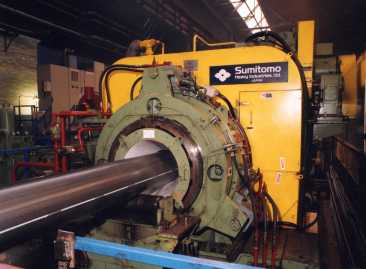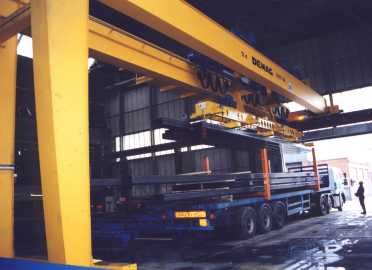

| THE SITE FOR THE TUBE AND PIPE INDUSTRIES |
|
David Simmons, British Steel Tubes & Pipes, Hartlepool, England

British Steel Tubes & Pipes has invested £4.4 million in expanding its capacity to produce Cold Formed Square and Rectangular Structural Hollow Sections at the Hartlepool 20" HFI (High Freqency Induction Welding) Pipe Mill. This investment allows the company to offer an extended range of cold formed products. The largest size is up from the previous maximum of 150 x 150 x 8mm to 300 x 300 x 12.5mm. British Steel maintains its leading position with the largest hollow section product range in Europe and the potential to extend further to 400 x 400. The Hartlepool 20" Pipe Mill already produced High Pressure Line Pipe for onshore and offshore oil and gas transmission, casing pipe for the oil country tubular goods market, cold formed circular hollow section (CHS) and hot finished square and rectangular hollow section for the construction market. This extension, with cold formed square and rectangular hollow section, complements the existing range of products from British Steel Tubes & Pipes' Hartlepool and Corby plants and maintains the company's position at the forefront of the industry.
A key element in the project was the need to continue with the high output levels for existing products throughout the period of the enhancement. A project team was formed in May 1997 consisting of a Project Manager, Project Engineer (also an Electrical Engineer), Plant Engineer, Mechanical Engineer, Plant Operations Manager Tooling Engineer, Accountant and a Quality engineer. This team also reported to a Steering Committee on a regular basis throughout the lifetime of the project. The existing weld mill was still to be used for the production of the new Cold Formed Square and Rectangular Structural Hollow Sections. This meant the process route and associated handling equipment needed to run without affecting the smooth running of the current production of other products. To compound this problem, the Hartlepool mill had a high loading throughout the enhancement project period including a number of prestigious offshore orders. A particular concern was that the new equipment for the cold formed process was installed without affecting pipe production, which utilises inclined benches to move the pipe by rolling. A method of moving the cold formed sections from the weld mill had to be found whilst retaining the inclined benches. A two bogey system was designed to carry the sections from one bay to another: the bogeys were adjustable so they remained bench height during the production of pipe and then, using hydraulics, rose above the bench to move the cold formed sections. The bogey design was by British Steel and they were assembled and installed by 20" pipe mill personnel. In addition to the tooling required to form the squares and rectangles, (which was designed and sourced by the 20" mill tooling engineer) and associated handling equipment to move the sections, a key item of the new product process route was a cut-off machine. This had to be capable of cutting the existing round products as well as the new squares and rectangles. The elements considered in deciding upon this equipment and supplier were the range of sizes to be cut, the quality of cut required, the speed of production and the price and delivery. It was decided to purchase the SHI (Sumitomo Heavy Industries) cutting machine from Japan as it could cut rounds, squares and rectangles and was of proven and reliable design, already being used in a number of mills in Japan.
 Brand new Sumitomo Saw This item was the single most expensive and had the longest delivery of all the equipment required for the project. It was also the last installed during the mill's summer shutdown in August 1998.
Magnet cranes were chosen as the quickest method of loading and unloading the Cold Formed Rectangular Hollow Section, partly because the product has flat surfaces. However, as this was to be used in the same area as the existing overhead crane lifting round products, at different times, it had to run underneath. A semi-goliath crane was chosen as the most effective way of moving the sections away from the weld mill.
 Semi-goliath Magnet crane A new warehousing area was created in existing covered bays adjacent to the main mill building and a new saw installed to cut test pieces prior to storage of the sections in carefully controlled pens. The existing Tandem Computers-based mill product tracking system programs had to be changed and extra hardware installed to accept the new Cold Formed Rectangular Hollow Section as it had previously dealt only with hot finished RHS. Cap Gemini working closely with the British Steel 20" mill computer section provided these modifications. The new sections, like all existing products from the 20" mill, have complete and individual traceability throughout production. New NDT (non-destructive testing) equipment was installed to test the weld area of the cold formed sections to ensure compliance with relevant specifications. The existing site for such testing is post sizing of the rounds, which for Cold Formed Rectangular Hollow Section was impractical as the product at that point is already square or rectangular. A new Unicorn station was installed immediately downstream of the welding point. The project to implement cold formed square and rectangular hollow section encompassed 13 months of work and each shutdown period at the mill gave an opportunity to progress civil engineering, preliminary installations and cabling. All this effort ensured that the final installation period in August 1998 successfully led to the planned production start up date of the 24th August 1998. Trials on proposed steel types were conducted throughout the project to build a database of properties and ensure that the new product would immediately attain the specified tensile and impact requirements. As each set of tooling was delivered to the mill a trial was conducted to ensure that it produced square and rectangular sections to the specified dimensional requirements. Product marking equipment was extensively tested as was the software, which enabled a unique identity to be applied to each section as it was produced. These trials, which produced a considerable amount of data, enabled the new product to be approved by the German Landesmaterialprufamt for the application of a 'U' mark signifying suitability for use in the German structural market, and allow for immediate delivery. An intensive training programme was initiated and applied on all new equipment and process routes and latterly involved teams of engineers visiting the SHI cut-off machine manufacturers in Japan for familiarisation. Engineers from Japan also came to the 20" mill to oversee and assist in the assembly, installation and testing of the cut-off machine and remained to help with commissioning and production operation. The first orders for the new product were received by British Steel Tubes & Pipes in June 1998 for planned delivery in September 1998. Production duly commenced on schedule on the 24th of August with manufacture of 180 x 180 mm Cold Formed Rectangular Hollow Section for the UK and a range of European continental customers.
British Steel Tubes & Pipes, |